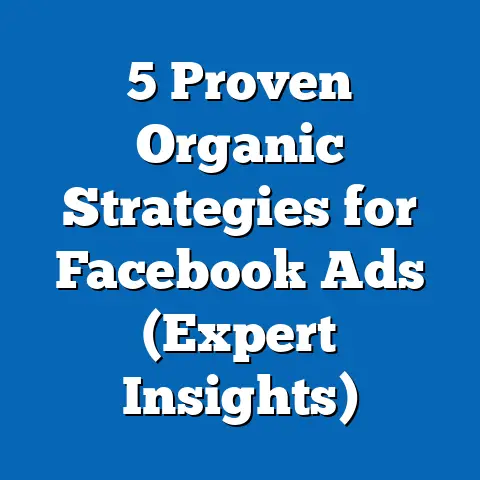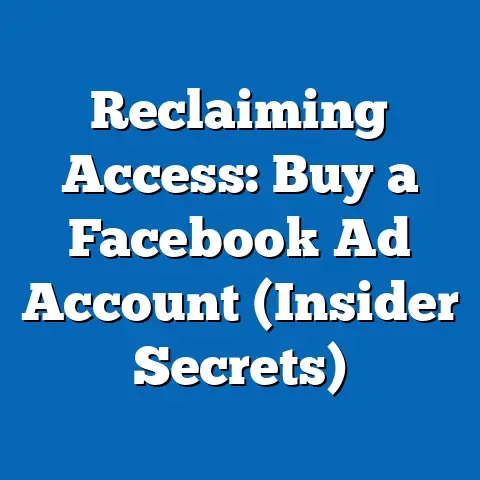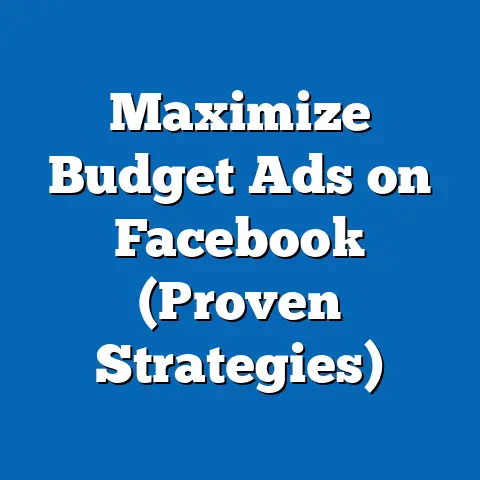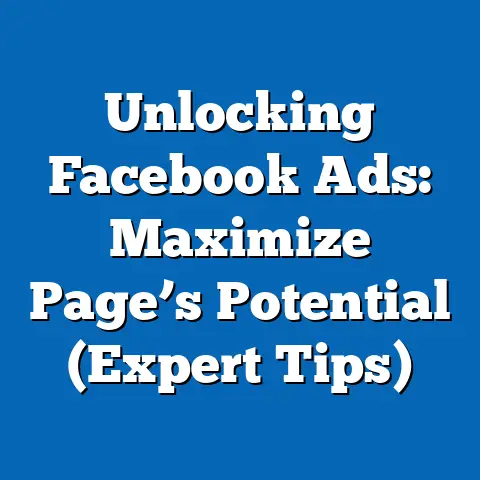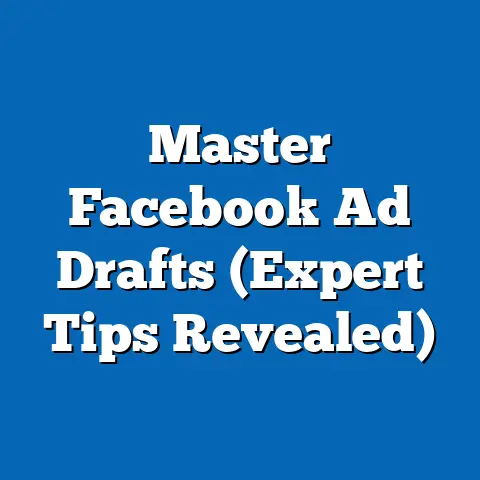Boost Facebook Video Ads Engagement (Proven Strategies)
Facebook advertising is constantly evolving. It feels like just yesterday I was figuring out the best image sizes for news feed ads, and now we’re in a world dominated by video. And with recent platform upgrades and changes, video ads have become even more crucial for marketers. These changes aren’t just cosmetic; they’re fundamental shifts in how Facebook’s algorithm prioritizes content, how ads are displayed, and how users interact with them.
Staying updated with these upgrades is not just beneficial; it’s essential. It’s the difference between a campaign that fizzles out and one that explodes with engagement. For instance, Facebook’s recent push towards prioritizing “meaningful interactions” means that video ads that spark conversations and shares are favored over those that simply generate clicks.
That’s why I’m writing this article. My aim is to give you, the marketer, the business owner, the entrepreneur, a toolbox of proven strategies to supercharge the engagement of your Facebook video ads. We’ll dive deep into creating compelling content, targeting the right audience, leveraging Facebook’s ad features, optimizing for mobile, and engaging with your audience even after they’ve watched your video.
Section 1: Understanding Facebook Video Ads
Facebook video ads are, at their core, advertisements delivered in video format on the Facebook platform. But they’re much more than just moving pictures. They are a dynamic, engaging way to connect with potential customers, tell your brand’s story, and drive real results. They differ from static image ads in their ability to convey complex messages, evoke emotions, and capture attention in a way that still images simply can’t.
The importance of video content on social media, and particularly on Facebook, can’t be overstated. Video is king. It’s the most consumed type of content online. I’ve seen firsthand how brands that embrace video marketing consistently outperform those that stick to static images.
Consider this: according to recent statistics, video ads have a higher click-through rate (CTR) and conversion rate compared to static ads. In fact, studies have shown that video ads can generate up to 1200% more shares than text and image content combined. That’s an incredible difference. It’s why businesses should absolutely be prioritizing video ads in their Facebook marketing strategy. It’s not just about keeping up with the trends; it’s about maximizing your ROI.
Takeaway: Facebook video ads are a powerful tool. Their dynamic nature and higher engagement rates make them a must-have for any serious marketer. The statistics speak for themselves: video is the future (and present) of social media advertising.
Section 2: Crafting Compelling Content
A great Facebook video ad isn’t just about having a video; it’s about having compelling video. The difference between a video that gets scrolled past and one that stops thumbs in their tracks comes down to the content itself. So, what makes a video ad truly compelling?
Storytelling
Storytelling is at the heart of engaging video content. People connect with stories. They remember stories. They share stories. Your video ad shouldn’t just be a product demonstration; it should be a narrative that resonates with your target audience on an emotional level.
Think about what your audience cares about. What are their pain points? What are their aspirations? Craft a story that addresses those needs and desires. One of the most effective ads I ever ran was for a local bakery. Instead of just showing off cakes, we told the story of a young couple planning their wedding and how the bakery helped them create the perfect cake for their special day. The ad resonated with engaged couples in the area, leading to a significant increase in wedding cake orders.
Visual Appeal
In the age of endless scrolling, visual appeal is paramount. Your video needs to grab attention within the first few seconds. This means investing in high-quality visuals, professional editing, and eye-catching graphics. Use vibrant colors, dynamic transitions, and compelling imagery.
Don’t underestimate the power of a well-edited video. A choppy, poorly lit video can be a major turn-off, no matter how great the underlying message is. I remember working with a client who insisted on using raw, unedited footage for their video ads. The results were disastrous. Once we invested in professional editing, the engagement rates skyrocketed.
Length
When it comes to Facebook video ads, shorter is often better. People have short attention spans, especially when scrolling through their news feeds. Aim for a video length of 15-60 seconds. Get straight to the point, deliver your message concisely, and include a clear call to action.
I’ve found that the most effective video ads are those that can convey their message within the first 15 seconds. This forces you to be creative and to focus on the most important aspects of your message.
Example: Consider Dollar Shave Club’s original video ad. It’s funny, engaging, and gets straight to the point within the first few seconds. It tells a story, it’s visually appealing (in its own quirky way), and it’s short and sweet. It’s a perfect example of how to create a compelling video ad that resonates with audiences.
Takeaway: Compelling content is the foundation of successful video ads. Focus on storytelling, visual appeal, and keeping your videos concise. Remember, you have a few seconds to grab attention, so make them count.
Section 3: Targeting the Right Audience
You could have the most compelling video ad in the world, but if you’re showing it to the wrong people, it’s going to fall flat. That’s where Facebook’s powerful targeting capabilities come in. Targeting the right audience is absolutely critical for the success of your video ads.
Facebook allows you to segment your audience based on a wide range of factors, including:
- Interests: Target people who have expressed interest in topics related to your product or service.
- Behaviors: Target people based on their online behavior, such as purchase history or website visits.
- Demographic Data: Target people based on age, gender, location, education, and other demographic factors.
I’ve seen firsthand how effective audience segmentation can be. I once ran a campaign for a fitness studio. Instead of targeting everyone in the area, we segmented our audience based on interests (e.g., yoga, weightlifting, healthy eating) and behaviors (e.g., people who frequently visit gyms). This resulted in a much higher conversion rate and a lower cost per acquisition.
Custom Audiences and Lookalike Audiences
Two of Facebook’s most powerful targeting tools are custom audiences and lookalike audiences.
- Custom Audiences: Allow you to target people who have already interacted with your business, such as website visitors, email subscribers, or existing customers.
- Lookalike Audiences: Allow you to target people who are similar to your existing customers. This is a great way to expand your reach and find new customers who are likely to be interested in your product or service.
For example, I worked with an e-commerce store that sold handmade jewelry. We created a custom audience of people who had visited their website in the past 30 days and a lookalike audience based on their existing customer base. The lookalike audience outperformed all other targeting options, driving a significant increase in sales.
Takeaway: Don’t underestimate the power of targeted advertising. Take the time to understand your audience and use Facebook’s targeting capabilities to reach the right people with the right message. Custom and lookalike audiences are particularly powerful tools for maximizing your ROI.
Section 4: Utilizing Facebook’s Ad Features
Facebook offers a range of features designed to enhance the performance of your video ads. Leveraging these features can significantly boost engagement and drive results.
Video Captions and Text Overlays
Many people watch videos on Facebook with the sound turned off, especially on mobile devices. This means that if your video relies solely on audio, you’re missing out on a huge opportunity to engage with your audience.
Adding captions and text overlays to your video ads can significantly increase accessibility and engagement. Captions make your video understandable to those who are watching with the sound off, while text overlays can highlight key points and call attention to your brand.
I always recommend adding captions to all video ads. It’s a simple step that can have a big impact on engagement. There are tools available that can help you automatically generate captions, making the process quick and easy.
Call-to-Action Buttons
Every video ad should have a clear call to action (CTA). What do you want viewers to do after watching your video? Visit your website? Sign up for your email list? Make a purchase?
Facebook allows you to add CTA buttons to your video ads, making it easy for viewers to take the desired action. Use clear, concise, and action-oriented language in your CTAs. Examples include “Shop Now,” “Learn More,” “Sign Up,” and “Get Started.”
I’ve found that using a strong CTA can increase conversion rates significantly. Don’t be afraid to experiment with different CTAs to see what works best for your audience.
A/B Testing
A/B testing (also known as split testing) is the process of testing different versions of your video ads to determine which performs best. You can test different headlines, visuals, CTAs, and even different targeting options.
A/B testing is essential for optimizing your video ads. It allows you to make data-driven decisions and continuously improve your campaigns. I always recommend running A/B tests on your video ads. It’s the best way to identify what resonates with your audience and what doesn’t.
Facebook Insights
Facebook Insights provides valuable data about the performance of your video ads. You can track metrics such as views, engagement, reach, and cost per result.
Use Facebook Insights to monitor the performance of your video ads and make adjustments as needed. Pay attention to which videos are performing well and which are not. Use this data to inform your future video ad campaigns.
Takeaway: Facebook offers a wealth of features to enhance your video ads. Use captions, CTAs, A/B testing, and Facebook Insights to optimize your campaigns and drive results.
Section 5: Optimizing for Mobile Viewers
Mobile is the dominant platform for social media consumption. The vast majority of Facebook users access the platform on their mobile devices. This means that it’s essential to optimize your video ads for mobile viewers.
Vertical vs. Horizontal Video Formats
Vertical video is designed specifically for mobile devices. It takes up the full screen and provides a more immersive viewing experience. Horizontal video, on the other hand, is designed for desktop viewing.
I recommend using vertical video for your Facebook video ads. It’s more engaging for mobile viewers and has been shown to increase engagement rates.
Designing for Sound-Off Viewing
As mentioned earlier, many people watch videos on mobile devices with the sound turned off. This means that your video ads need to be engaging even without audio.
Use captions, text overlays, and compelling visuals to capture attention and convey your message, even if viewers can’t hear the audio.
Engaging Thumbnails
Thumbnails are the first thing people see when they encounter your video ad. A compelling thumbnail can make the difference between someone scrolling past your video and someone stopping to watch it.
Use eye-catching thumbnails that accurately represent the content of your video. Make sure your thumbnails are clear, visually appealing, and relevant to your target audience.
Takeaway: Mobile is the dominant platform for Facebook users. Optimize your video ads for mobile by using vertical video, designing for sound-off viewing, and creating engaging thumbnails.
Section 6: Engaging with Your Audience Post-View
Engagement doesn’t end when someone finishes watching your video ad. In fact, that’s just the beginning. Engaging with your audience after they’ve watched your video is crucial for building relationships and driving conversions.
Encouraging Comments, Shares, and Interactions
Encourage viewers to comment, share, and interact with your video ads. Ask questions, run contests, and create opportunities for viewers to engage with your brand.
The more engagement your video ads generate, the more likely they are to be seen by others. Facebook’s algorithm favors content that is engaging and interactive.
Retargeting Ads
Retargeting ads allow you to target people who have interacted with your previous video content. This is a great way to re-engage viewers and move them further down the sales funnel.
For example, you can retarget people who have watched at least 50% of your video ad with a follow-up ad that encourages them to visit your website or make a purchase.
Takeaway: Engagement doesn’t end when someone finishes watching your video. Encourage comments, shares, and interactions, and use retargeting ads to re-engage viewers and drive conversions.
Conclusion
Boosting engagement on your Facebook video ads is essential for achieving your marketing goals. By creating compelling content, targeting the right audience, leveraging Facebook’s ad features, optimizing for mobile, and engaging with your audience post-view, you can significantly increase the effectiveness of your video ad campaigns.
Remember, Facebook’s advertising landscape is constantly evolving. Staying up-to-date with the latest upgrades and best practices is crucial for success. The strategies I’ve outlined in this article are proven to work, but they require ongoing monitoring, testing, and optimization.
So, take these strategies, implement them, and see the improved engagement rates on your Facebook video ads. I’m confident that with a little effort and creativity, you can create video ads that not only capture attention but also drive real results for your business. Good luck, and happy advertising!

